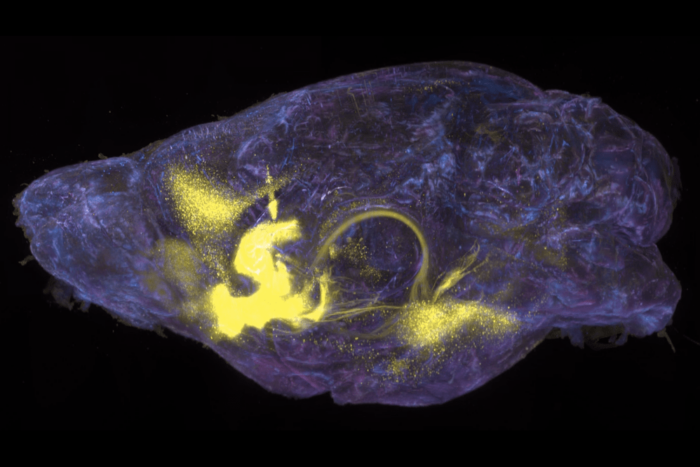Researchers Solve Killer Protein's "Crime"

Developing fly eyes provide Rockefeller University scientists with a tool to measure the ability of proteins to trigger cell death. The experiment above shows that excess quantities of the killer protein Reaper normally trigger the death of fly eye cells, resulting in a smaller than normal eye (left). But when levels of a ubiquitinating or "garbage disposal" enzyme called ubcD1 are reduced, Reaper can no longer function as well — as indicated by the larger eye (right). By using this and other fly techniques, Rockefeller researchers were able to show that Reaper induces natural cell death by first stimulating a guard protein, called DIAP1, to self-destruct via ubiquitination, a natural process in which unwanted proteins are tagged for destruction and subsequently disposed.
A killer protein named Reaper. A protective protein in bits and pieces. And a dead cell. This is the scene of one of the body’s most perfect crimes: programmed cell death. This vital process occurs throughout life as a means to, among other purposes, eliminate potentially cancerous cells.
Now, by reconstructing the scene of the crime in the fruit fly Drosophila melanogaster, researchers at the Rockefeller University have hit upon a startling finding regarding just how Reaper carries out its murderous task.
Moreover, because cancer arises in part by outwitting programmed cell death, the results, reported in the June issue of Nature Cell Biology, may lead to novel strategies for putting this protective mechanism back into place.
“Based on this kind of knowledge, it may be possible to derive Reaper-like drugs that specifically kill off immortal cancer cells, without harming healthy cells,” says Hyung Don Ryoo, Ph.D., a postdoctoral fellow at Rockefeller and first author of the paper.
Other authors of this paper include Andreas Bergmann, assistant professor at M.D. Anderson Cancer Center, University of Texas, Houston, Texas; Hedva Gonen, scientist and Aaron Ciechanover, professor at Technion-Israel Institute of Technology, Israel; and Hermann Steller, Ph.D., Strang Professor at Rockefeller, Howard Hughes Medical Institute investigator and principal author of the new report.
Programmed cell death occurs throughout a human’s body both during development as a means to sculpt critical organs and tissues, and in adulthood as a housekeeping function, whereby potentially harmful cells are eliminated. Fruit flies also experience a similar kind of programmed cell death and thus are excellent model organisms in which to study this process.

Hyung don Ryoo (right) and Hermann Steller show, for the first time, that the killer protein Reaper stimulates the ubiquitin ligase activity of Drosophila IAP1 — a novel finding that may expand our understanding of how cells regulate protein stability.
According to the new research, Reaper triggers programmed cell death, or as scientists say “apoptosis,” by instructing a fly cell’s principal guard protein, called Drosophila IAP1, or DIAP1, to in essence self-destruct. Once DIAP1 is gone, a cell automatically begins to die.
“The self-destruction of this key protein leads to the self-destruction of the entire cell,” says Steller, who heads the Strang Laboratory of Apoptosis and Cancer Biology at Rockefeller.
Because most human cancers have gained resistance to programmed cell death by boosting their population of IAPs (“Inhibitors of Apoptosis Protein”), literally gaining strength in numbers, drugs derived from Reaper might bring these levels back down, making cancer cells more susceptible to programmed cell death.
“Small molecule drugs designed to imitate Reaper’s ability to eliminate IAPs would potentially target only cancer cells, leaving healthy cells unharmed,” says Steller. “This kind of therapy should result in fewer side-effects.”
More Than Garbage Disposal System
In their latest research, the Rockefeller researchers demonstrate that Reaper triggers DIAP1 to undergo a process known as auto-ubiquitination, which essentially amounts to protein suicide. Ubiquitination, like its name implies, takes place in every cell at all times and is the body’s main system for eliminating protein waste; proteins called ubiquitin ligases, such as DIAP1, tag proteins that are no longer needed by the cell with a small molecule called ubiquitin, which then signals a large protein complex called the proteasome to essentially chew it up and spit it out. Auto-ubiquitination occurs when a protein marks itself for destruction.
But over the past few years scientists have come to realize that ubiquitination is much more than a garbage disposal system; rather, it is one of the cell’s principal strategies for regulating the amount of a given protein in a cell. Moreover, a malfunctioning ubiquitination system can lead to several diseases, including cancer, autoimmune disease and such neurodegenerative diseases as Parkinson’s.
The latest finding that Reaper stimulates DIAP1 to ubiquitinate itself not only represents a novel cell death mechanism, but marks a “first” in the field of ubiquitination.
“For the first time, we have shown that another protein (Reaper) enhances the activity of a ubiquitinating ligase (DIAP1),” says Ryoo. “The rate of DIAP1 ubiquitination is not constant, but is actively stimulated in cells that are fated to die.”
Gas and Brake Model of Cell Death

The protein DIAP1 normally keeps a tight leash on the deadly caspases (red), shown above outside of the nuclei (green) of developing fly embryo cells. But when the protein Reaper stimulates DIAP1 to self-destruct, the caspases are released and natural cell death ensues.
The primary executioners in programmed cell death are proteins called caspases. These are the proteins that wreak havoc on a cell and eventually kill it. Other proteins, which Steller calls the “gas,” signal a cell to activate caspases when its time to die.
But in a healthy cell the presence of active caspases is not enough to induce cell death; these deadly molecules are kept on a tight leash by the IAPs, or, as Steller calls them, “the brakes on death.”
Consequently, before cell death can occur these “brakes” must be released. This is the job of the Reaper family of proteins, which includes Reaper, Hid and Grim, and which Steller discovered in 1994.
“Reaper is like a molecular switch that triggers cell death by inactivating a “pro-life” IAP protein, DIAP1. In living cells, DIAP1 is abundant and prevents apoptosis,” says Ryoo. “But in cells that are doomed to die, Reaper inactivates DIAP1, which then leads to the release of the caspases.”
“Reaper, Hid and Grim are like the keys that unlock the chains of deadly caspases,” adds Steller.
But, until now, scientists did not know the precise mechanism by which the Reaper family of proteins inactivated the IAPs, or, in other words, released the breaks on death.
The new Rockefeller research is the first to show that Reaper, but not Hid, inactivates DIAP1 by triggering its disapperance. In the past, scientists could not easily study the effects of Reaper in developing fly embryos because overproduction of this protein leads to their death. But the researchers solved this problem by inducing the fly embryos to simultaneously overproduce both Reaper and an anti-apoptosis protein called p35. This new technique enabled them to observe that Reaper causes a drop in DIAP1 protein levels.
RING Fingers Tag Proteins for Destruction
To assess the possibility that Reaper stimulates the self-destruction or auto-ubiquitination of DIAP1, the researchers took advantage of a known fact about this protein removal process. About four years ago, scientists discovered that the proteins responsible for tagging other proteins (or themselves) for destruction contained a structural element known as a RING finger, for “Really Important New Gene.” This “motif,” as scientists call it, adds ubiquitin molecules to unwanted proteins. Since the scientists already knew that the fly’s one IAP, called DIAP1, contained a RING finger, they set out to observe the effects of mutating it in developing fly embryos.
Under this experimental condition, Reaper no longer triggered the disappearance of DIAP1. This finding, in addition to several other important experiments reported in the Nature Cell Biology paper, offers proof that Reaper stimulates auto-ubiquitination of DIAP1.
“It makes sense that an irreversible process like ubiquitination would be involved in cell death,” says Ryoo. “An important part of programmed cell death is DNA fragmentation, so if any cells were to survive they would most definitely have mutations and thus could lead to cancer. The body wouldn’t want to risk this.”
The researchers say that drugs designed to imitate certain aspects of Reaper’s function would be highly specific and efficient at fighting cancer. Because Reaper itself is a very small protein, they think that it will be possible to design small therapeutic derivatives of it that could readily pass into tumor cells.
Says Steller, “Since the survival of certain tumor cells appears to depend on high-level over-expression of certain IAPs, reducing these abnormally high protein levels with a Reaper-like drug should selectively kill these tumors without detrimental side effects on normal cells.”
This research was funded by the Leukemia-Lymphoma Society, Howard Hughes Medical Institute, the Strang Cancer Center and the National Institutes of Health. Steller acknowledges the Lady Davis Fellowship from the Technion-Israel Institute of Technology, which supported the collaboration with the Ciechanover laboratory.
John D. Rockefeller founded Rockefeller University in 1901 as The Rockefeller Institute for Medical Research. Rockefeller scientists have made significant achievements, including the discovery that DNA is the carrier of genetic information. The University has ties to 21 Nobel laureates, six of which are on campus. Rockefeller University scientists have received this award for two consecutive years: neurobiologist Paul Greengard, Ph.D., in 2000 and cell biologist Günter Blobel, M.D., Ph.D., in 1999, both in Physiology or Medicine. At present, 33 faculty are elected members of the U.S. National Academy of Sciences. Celebrating its Centennial anniversary in 2001, Rockefeller – the nation’s first biomedical research center – continues to lead the field in both scientific inquiry and the development of tomorrow’s scientists.


